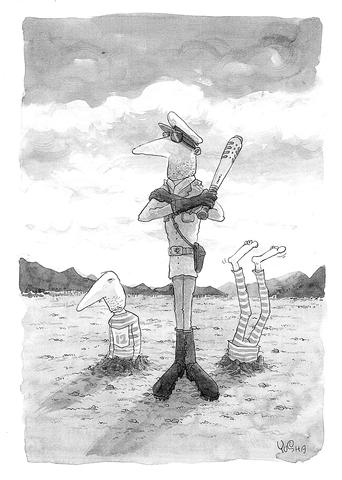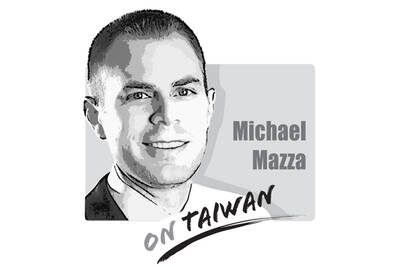It's one of those toys that enterprising manufacturers have developed that sound real good, but their potential for abuse is so great, and in the hands of a torturer, the 'toy' can produce cruel, even fatal, results" says Armond Start, a professor at the National Center for Correctional Health Care Studies. The toys Start refers to are police stun weapons. They are police "toys" whose use ought to be completely banned in Taiwan.
Police stun weapons have been in the news lately. Last week the human rights group Amnesty International released a report entitled Stopping the Torture Trade. Taiwan had the dubious distinction of being highlighted twice in the report. First as a kind of national poster child for how not to regulate the export of stun guns and then as the Asian example of police use of stun guns as torture devices.
Laying aside the issue of export regulations for stun weapons, my focus here will be on the reasons their use or possession by our police forces should be banned by law.

By Yu Sha
The term "stun weapons" is a generic term for a range of different devices including stun guns, stun batons, tasers and stun shields. What all these devices have in common is their use of electrical discharges to incapacitate another person, incapacitate being a euphemism for a range of things from torture, knocking down, knocking out, to killing a suspect.
The other thing they have in common is that they are, at least by their manufacturers, hyped as "non-lethal police defensive tools." That is a euphemism for stopping a suspect without using a firearm or a fist.
A stun gun is a small device about the size and shape of a cell phone. To use one you push it up against the suspect's body, which brings the two probes into contact with the body. A switch then causes the weapon to discharge 50,000 volts into the suspect. This is the device Taipei street cops are commonly seen carrying. Stun batons are shaped like wooden batons and work in basically the same manner as the smaller stun guns. In essence they are cattle prods. Stun shields are as the name implies, a type of shield that can discharge shocks when contact is made with the front of it. These devices are most commonly used by anti-riot police. All three require direct physical contact with the suspect.
The fourth device, the taser, shoots two fishhook like darts that are connected by thin wires to the power unit. Tasers function the same way as the other stun weapons but can be shot at the suspect from up to 4.5m away.
The manufacturers of these devices claim they are safe, non-lethal devices that can be used to subdue suspects with injuring them. That hype is unsupported by the facts. In the US there have been a number of suspect deaths resulting from the use of stun weapons and several states have already banned their use by police officers. There have been no medical studies done that establish that these devices are "safe, non-lethal."
Taiwan's police forces should be absolutely banned from possessing or using these devices for a very simple reason. All police tools should be subject to a simple risk versus benefits analysis. This is a balancing test where the risk of the device is weighed against the benefits of such a device. Under such an analysis, the risk of letting the local cops have stun weapons far, far outweighs any possible benefit that could come of it.
Let us turn first to the risk. The major risk associated from stun weapons is their potential for abuse, that is their potential to be used by the police as a torture or intimidation tool. Stun weapons are a police torturer's dream. They are inexpensive, they are light to carry, they run on ordinary batteries, they make a loud and ominous crackling sound when they are discharged. They can be used through clothing, they can be stabbed into any part of the body. They leave few, if any traces. Electric torture has long been a favorite of torturers. Stun weapons are a perfect way to deliver it.
James Jaranson, at Minne-sota's Center for Victims of Torture says it best: "The electricity is extremely painful, it can be controlled by the torturer and it leaves very few incriminating marks."
Add to this the long established reputation of Taiwan's police force for torture mixed with its immunity, de facto granted by the court system and you have a perfect formula for human rights abuses.
Turning to the supposed benefits of stun weapons; they are touted as an excellent non-lethal alternative to firearms. Usually a false dilemma is put forward; "well, is it better to shoot the suspect or stun him?" Those are not the only two choices.
Stun weapons as a police defensive tool have a number of problems. Stun weapons, to be effective, as a non-lethal form of police defense, requires extensive and ongoing training. Extensive and ongoing training is a totally alien concept to Taiwan's police force. Police defensive tactics instructors will be quick to point out also that there are very few situations where stun weapons can really provide any measure of protection to a police officer. On the contrary they can easily give the officer a false sense of security.
I certainly agree that Taiwan's police force needs non-lethal defensive weapons. They do not need stun guns, what they need is a traditional police tool: wooden batons, not stun weapons which lend themselves so easily to abuse. Standard, non-electric, batons have a long and established track record of success as a police defensive tool. Now of course "old fashioned" batons, also known as nightsticks, can be used as a tool of police torture and abuse. But there is a fundamental difference between stun weapons and batons; stun weapons leave few clues as to their use, batons leave far more obvious clues. Stun weapons invite abuse, standard batons do not to such a "tempting" extent.
The bottom line is that the risk of police misuse of stun weapons far, far outweighs their very limited usefulness as a legitimate police tool. Thus they should not be in the hands of Taiwan's police force.
Brian Kennedy is an attorney who writes and teaches on criminal justice and human rights issues.
The US Senate’s passage of the 2026 National Defense Authorization Act (NDAA), which urges Taiwan’s inclusion in the Rim of the Pacific (RIMPAC) exercise and allocates US$1 billion in military aid, marks yet another milestone in Washington’s growing support for Taipei. On paper, it reflects the steadiness of US commitment, but beneath this show of solidarity lies contradiction. While the US Congress builds a stable, bipartisan architecture of deterrence, US President Donald Trump repeatedly undercuts it through erratic decisions and transactional diplomacy. This dissonance not only weakens the US’ credibility abroad — it also fractures public trust within Taiwan. For decades,
In 1976, the Gang of Four was ousted. The Gang of Four was a leftist political group comprising Chinese Communist Party (CCP) members: Jiang Qing (江青), its leading figure and Mao Zedong’s (毛澤東) last wife; Zhang Chunqiao (張春橋); Yao Wenyuan (姚文元); and Wang Hongwen (王洪文). The four wielded supreme power during the Cultural Revolution (1966-1976), but when Mao died, they were overthrown and charged with crimes against China in what was in essence a political coup of the right against the left. The same type of thing might be happening again as the CCP has expelled nine top generals. Rather than a

The ceasefire in the Middle East is a rare cause for celebration in that war-torn region. Hamas has released all of the living hostages it captured on Oct. 7, 2023, regular combat operations have ceased, and Israel has drawn closer to its Arab neighbors. Israel, with crucial support from the United States, has achieved all of this despite concerted efforts from the forces of darkness to prevent it. Hamas, of course, is a longtime client of Iran, which in turn is a client of China. Two years ago, when Hamas invaded Israel — killing 1,200, kidnapping 251, and brutalizing countless others
A Reuters report published this week highlighted the struggles of migrant mothers in Taiwan through the story of Marian Duhapa, a Filipina forced to leave her infant behind to work in Taiwan and support her family. After becoming pregnant in Taiwan last year, Duhapa lost her job and lived in a shelter before giving birth and taking her daughter back to the Philippines. She then returned to Taiwan for a second time on her own to find work. Duhapa’s sacrifice is one of countless examples among the hundreds of thousands of migrant workers who sustain many of Taiwan’s households and factories,